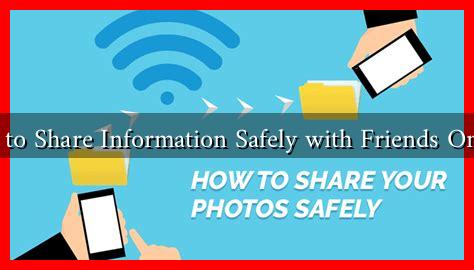-
Table of Contents
- How to Share Information Safely with Friends Online
- Understanding the Risks of Sharing Information Online
- Best Practices for Safe Information Sharing
- 1. Use Secure Platforms
- 2. Limit Personal Information
- 3. Adjust Privacy Settings
- 4. Verify Recipients
- 5. Use Strong Passwords and Two-Factor Authentication
- Tools to Enhance Your Online Safety
- Case Studies: Learning from Real-Life Examples
- Conclusion: Stay Informed and Vigilant
How to Share Information Safely with Friends Online
In today’s digital age, sharing information with friends online has become a common practice. Whether it’s through social media, messaging apps, or email, the ease of communication is unparalleled. However, with this convenience comes the responsibility of ensuring that the information shared is done safely. This article will explore effective strategies for sharing information securely with friends online, highlighting best practices, potential risks, and tools that can help protect your data.
Understanding the Risks of Sharing Information Online
Before diving into how to share information safely, it’s essential to understand the risks involved. The internet is rife with threats that can compromise your personal information. Some of the most common risks include:
- Identity Theft: Cybercriminals can use your personal information to impersonate you, leading to financial loss and damage to your reputation.
- Data Breaches: Many platforms have experienced data breaches, exposing users’ information to unauthorized parties.
- Phishing Attacks: Scammers often use deceptive emails or messages to trick individuals into revealing sensitive information.
- Privacy Invasion: Sharing too much information can lead to unwanted attention or harassment.
Best Practices for Safe Information Sharing
To mitigate these risks, consider the following best practices when sharing information online:
1. Use Secure Platforms
Choose platforms that prioritize user security. Look for features such as end-to-end encryption, which ensures that only the sender and recipient can read the messages. Popular apps like Signal and WhatsApp offer this level of security.
2. Limit Personal Information
Be mindful of the information you share. Avoid disclosing sensitive details such as your home address, phone number, or financial information. Instead, share only what is necessary for the conversation.
3. Adjust Privacy Settings
Most social media platforms allow you to customize your privacy settings. Ensure that your profile is set to private, and only share posts with friends or trusted individuals. Regularly review your settings to keep up with any changes made by the platform.
4. Verify Recipients
Before sharing any information, verify the identity of the person you are communicating with. This is especially important in group chats or when receiving unsolicited messages. If in doubt, reach out to the person through a different communication method to confirm their identity.
5. Use Strong Passwords and Two-Factor Authentication
Protect your accounts with strong, unique passwords and enable two-factor authentication (2FA) wherever possible. This adds an extra layer of security, making it more difficult for unauthorized users to access your accounts.
Tools to Enhance Your Online Safety
Several tools can help you share information safely online:
- Password Managers: Tools like LastPass or 1Password can help you create and store strong passwords securely.
- VPNs: A Virtual Private Network (VPN) encrypts your internet connection, making it harder for hackers to intercept your data.
- Antivirus Software: Keep your devices protected with reliable antivirus software to guard against malware and phishing attacks.
Case Studies: Learning from Real-Life Examples
Understanding the consequences of unsafe information sharing can be enlightening. For instance, in 2019, a major data breach at Facebook exposed the personal information of over 540 million users. This incident highlighted the importance of being cautious about what we share and where we share it. Similarly, the infamous Target data breach in 2013, which compromised the credit card information of millions, serves as a reminder of the vulnerabilities present in online transactions.
Conclusion: Stay Informed and Vigilant
Sharing information with friends online can be done safely by following best practices and utilizing the right tools. By understanding the risks, limiting personal information, and using secure platforms, you can protect yourself and your friends from potential threats. Remember, staying informed and vigilant is key to navigating the digital landscape safely. For more information on online safety, consider visiting resources like the Federal Trade Commission’s Online Security page.

